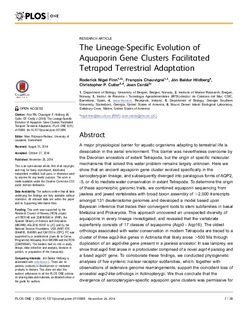| dc.contributor.author | Finn, Roderick Nigel | |
| dc.contributor.author | Chauvigné, François | |
| dc.contributor.author | Hlidberg, Jón Baldur | |
| dc.contributor.author | Cutler, Christopher P. | |
| dc.contributor.author | Cerdà, Joan | |
| dc.date.accessioned | 2015-01-29T14:50:58Z | |
| dc.date.available | 2015-01-29T14:50:58Z | |
| dc.date.issued | 2014-11-26 | |
| dc.identifier.citation | Finn RN, Chauvigne´ F, Hlidberg JB, Cutler CP, Cerda` J (2014) The Lineage-Specific Evolution of Aquaporin Gene Clusters Facilitated Tetrapod Terrestrial Adaptation. PLoS ONE 9(11):e113686. doi:10.1371/journal.pone.0113686 | nb_NO |
| dc.identifier.issn | 1932-6203 | |
| dc.identifier.uri | http://hdl.handle.net/11250/275061 | |
| dc.description.abstract | A major physiological barrier for aquatic organisms adapting to terrestrial life is dessication in the aerial environment. This barrier was nevertheless overcome by the Devonian ancestors of extant Tetrapoda, but the origin of specific molecular mechanisms that solved this water problem remains largely unknown. Here we show that an ancient aquaporin gene cluster evolved specifically in the sarcopterygian lineage, and subsequently diverged into paralogous forms of AQP2, -5, or -6 to mediate water conservation in extant Tetrapoda. To determine the origin of these apomorphic genomic traits, we combined aquaporin sequencing from jawless and jawed vertebrates with broad taxon assembly of >2,000 transcripts amongst 131 deuterostome genomes and developed a model based upon Bayesian inference that traces their convergent roots to stem subfamilies in basal Metazoa and Prokaryota. This approach uncovered an unexpected diversity of aquaporins in every lineage investigated, and revealed that the vertebrate superfamily consists of 17 classes of aquaporins (Aqp0 - Aqp16). The oldest orthologs associated with water conservation in modern Tetrapoda are traced to a cluster of three aqp2-like genes in Actinistia that likely arose >500 Ma through duplication of an aqp0-like gene present in a jawless ancestor. In sea lamprey, we show that aqp0 first arose in a protocluster comprised of a novel aqp14 paralog and a fused aqp01 gene. To corroborate these findings, we conducted phylogenetic analyses of five syntenic nuclear receptor subfamilies, which, together with observations of extensive genome rearrangements, support the coincident loss of ancestral aqp2-like orthologs in Actinopterygii. We thus conclude that the divergence of sarcopterygian-specific aquaporin gene clusters was permissive for the evolution of water conservation mechanisms that facilitated tetrapod terrestrial adaptation. | nb_NO |
| dc.language.iso | eng | nb_NO |
| dc.publisher | Public Library of Science | nb_NO |
| dc.rights | Navngivelse 3.0 Norge | * |
| dc.rights.uri | http://creativecommons.org/licenses/by/3.0/no/ | * |
| dc.title | The Lineage-Specific Evolution of Aquaporin Gene Clusters Facilitated Tetrapod Terrestrial Adaptation | nb_NO |
| dc.type | Journal article | nb_NO |
| dc.type | Peer reviewed | nb_NO |
| dc.source.pagenumber | 38 p. | nb_NO |
| dc.source.volume | 9 | nb_NO |
| dc.source.journal | PLoS ONE | nb_NO |
| dc.source.issue | 11 | nb_NO |
| dc.identifier.doi | 10.1371/journal.pone.0113686 | |
| dc.relation.project | Norwegian Research Council: #178837/40 and 224816/E40 | nb_NO |

